Thuja western "Yellow Ribbon": description and subtleties of cultivation

A popular coniferous plant in landscape design - thuja western "Yellow Ribbon" - has a recognizable pyramidal crown shape and belongs to the category of evergreens. In winter, the tree acquires a golden brown tone, in spring it pleases with orange notes, and summer needles have a green tint with golden yellow ends of the needles. This garden detail always looks luxurious and brings fresh colors to the Central Russian landscape. The plant is quite unpretentious in care, suitable for planting even for inexperienced owners, demonstrates rapid growth.
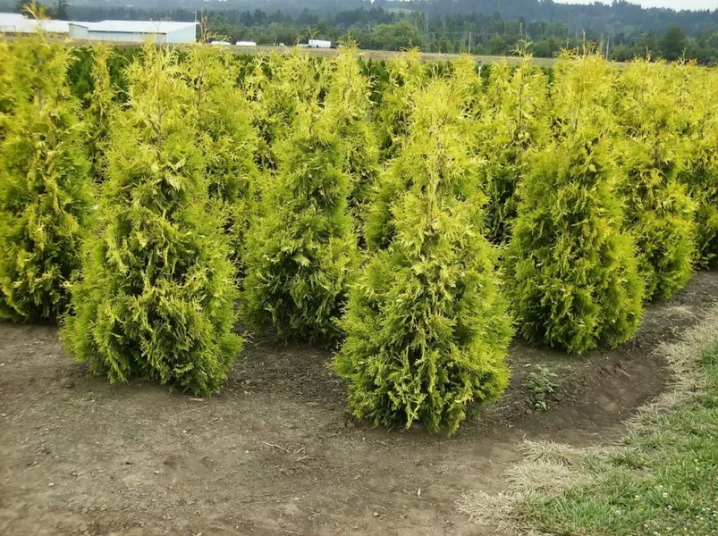
Description and main characteristics
Description of the variety of thuja "Yellow Ribbon" (botanical name Thuja occidentalis yellow ribbon) allows you to get complete information about its appearance. Among the main parameters are the following.
- The size of an adult tree. Its height reaches 2.0–2.5 m, the average time to reach this indicator is 15 years. Upward, the tree grows 10–12 cm, in diameter it increases by no more than 8 cm (maximum indicators - 0.8 m).
- Crown shape - conical, is close to teardrop-shaped, with a rounded base and a sharp top. The growth density of the branches is high, and many shoots are formed.
- The main properties of the variety: high frost resistance - the ability to withstand cold up to -35 degrees Celsius; wind resistance of the plant; resistance to ultraviolet rays.
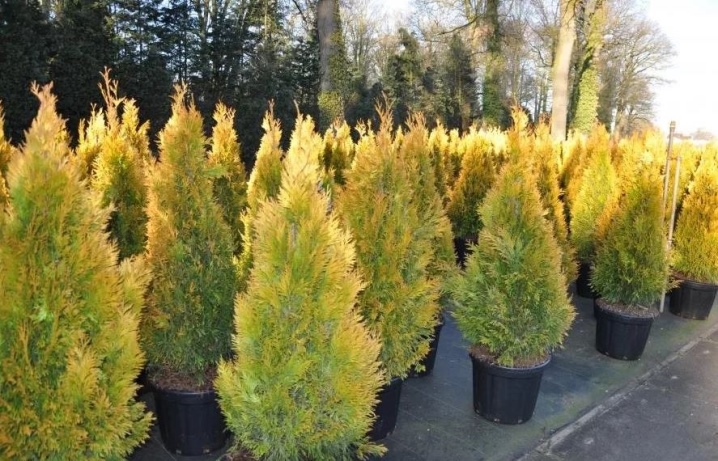
Thuja western "Yellow Ribbon" - a bright representative of the cypress family, belongs to its slow-growing branch (with a trunk growth of up to 15 cm per year). Plants of this species are able to grow on the site for more than half a century without losing their attractiveness, are resistant to diseases, and adapt well during transplantation.
Reproduction methods
A popular ornamental plant with bright needles - the western Yellow Ribbon - can be propagated in one of two ways. When breeding from seeds, the variety loses its characteristics - this is how you can get an ordinary wild plant without any characteristic color features. Growing a seedling in this case takes up to 5 years. With this reproduction, the resulting plant will be immediately adapted to the climatic conditions of the area. The cutting method of vegetation allows you to get thuja that retain their varietal characteristics. A shoot of the second or third year is separated from the trunk, from the top of the parent tree. After the cutting has formed a root system, it is planted in the ground or in a container for further cultivation in a closed format.
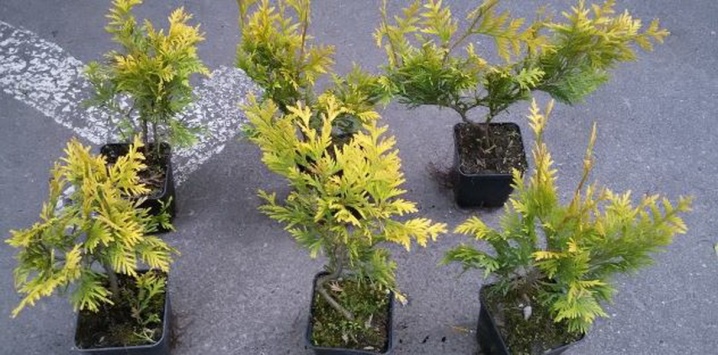
Choosing a place for a thuja
Conifers of the western thuja species are unpretentious in choosing a place for planting them. The plant is recommended to be placed in dry areas with loamy and sandy loam soils. An area with a high groundwater level is not suitable, but access to moisture is important to maintain the brightness of the needles. With constant flooding of the roots, the plant develops late blight, from which the thuja does not have sufficient protection. There are also requirements for the acidity of the soil - it must be in the pH range of 4.5–6.5.
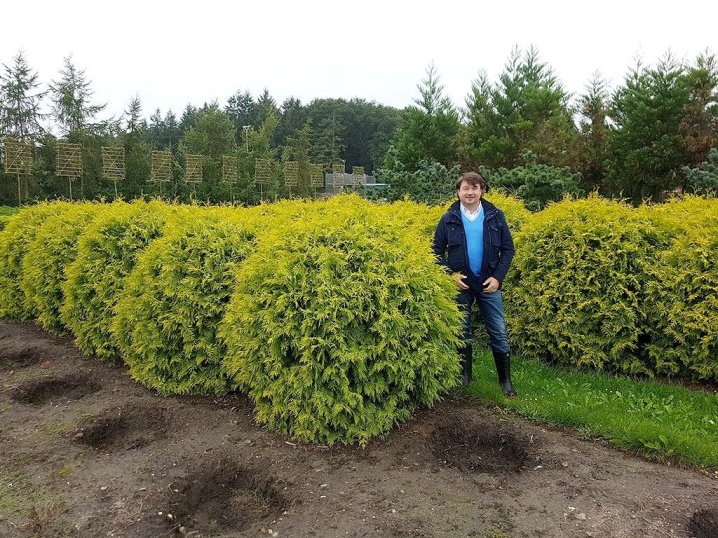
When choosing a place for the "Yellow Ribbon" thuja, it is worth considering that it only tolerates the sun in doses. - it is better if its rays hit the crown in the morning or evening hours. During the day, it is better to provide the plant with light partial shade, otherwise the needles may burn.With a lack of light, the tree loses its unusual color, the crown becomes less dense. It is not recommended to plant the western thuja in the immediate vicinity of large deciduous plants. Trees such as maple, birch, poplar as neighbors will deprive the ephedra of nutrients from the soil. With a shallow root system, thuja needs to be planted in an environment with trees of a similar type.

Features of choosing a seedling
Exotic decorative thuja "Yellow Ribbon" is a very popular plant among gardeners. It is the high demand that leads to multiple falsifications related to the sale of seedlings. In order not to be mistaken in choosing a young tree for planting a western thuja, you should pay attention to the following points.
- Root system type. At the closed above, survival rate, while the plant should not easily come out of the pot along with a lump of earth. Roots in drainage holes are a good sign. With an open system, there should be no rot, mold, any deforming nodes, growths, formations on the surface of the rhizome.
- Crown health. The needles of a healthy western thuja should have an elastic, strong structure. The shade must correspond to the varietal characteristic. If in doubt, wipe the tip of the branch with a damp cloth. If there are traces of paint on it, a less exotic version is given out as a noble decorative variety.
- The state of the trunk and branches. If the seedling is infested with parasites, they will be visible on visual inspection. Resin drips, holes in the bark, and other foreign marks on the surface of the trunk are a reason for refusing to purchase.
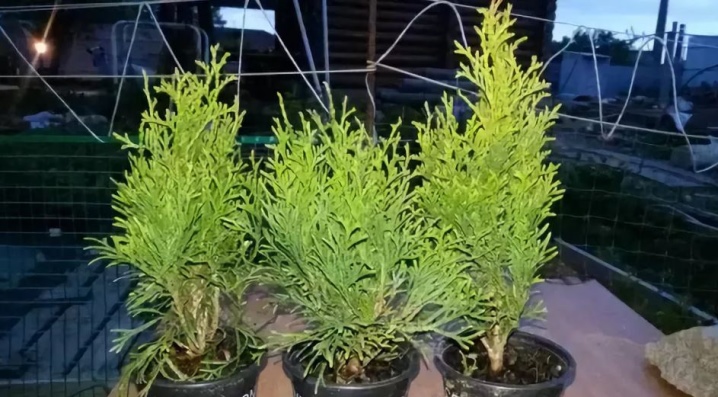
Landing subtleties
The main difficulties for gardeners are planting and caring for the western Yellow Ribbon thuja. But on closer inspection, these processes are not a hassle. A seedling bought in a nursery in a pot, with a closed type of root system, can be planted at any time of the year, from April to October. For the plant to take root, it needs at least 30 days before the onset of the first frost. With an open root system in the northern regions, planting is carried out in the spring, in the southern regions - in the middle of autumn.
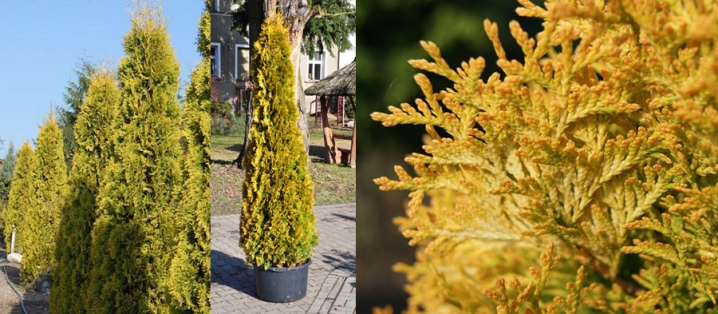
When planting thuja "Yellow Ribbon", you need to prepare a hole that exceeds the volume of the root system by 0.2 m in height, width and length. Drainage from expanded clay, pebbles, crushed stone or brick is laid in the base. Further, up to half is filled with nutrient soil with a predominance of previously excavated soil with the addition of sand and peat. When planting, the root collar of the seedling should be at the level of the edge of the pit.

At the end of planting, the roots are covered with the remnants of the soil mixture, carefully compacting it. The first watering is carried out - it should be abundant enough. It will be useful to add a rooting stimulator to the liquid. It will help improve the survival rate of the seedling.
Plant care
To regular care of thuja western "Yellow Ribbon" include the following procedures.
- Watering. A moisture-loving plant requires a mandatory replenishment of liquid reserves. In the heat, watering is done three times a week, the rest of the time weekly, 1 bucket at a time. Sprinkling is useful for the tree, showing brightness of color and stimulating the release of essential substances.
- Top dressing. It is not necessary for the first 2 years. After that, it is recommended to introduce potassium and phosphorus additives, but nitrogen compositions are contraindicated for slow-growing varieties for most of the year, they are introduced only in the spring. Fresh organic fertilizers are not too useful for thuja.
- Weeding and loosening the soil. The close location of the root system to the soil surface increases the need for western thuja for the quality of aeration. Weeding and loosening helps to normalize air exchange. Mulching the root zone will be useful.
- Pruning the crown. It is carried out only for sanitary reasons, regular haircut is not required.When forming the original crown of a non-teardrop type, when pruning, it is forbidden to touch more than 1/3 of the shoots or cut off the top.
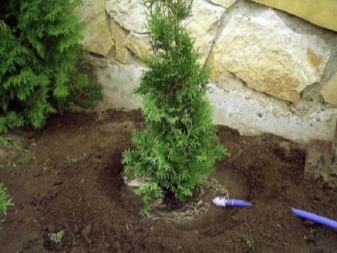
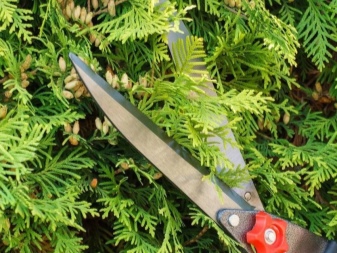
Application in landscape design
Thuja western variety Yellow Ribbon is considered an excellent element of the decorative design of the site. With its help, you can easily form an original hedge of medium height. The tree is also suitable for urban landscaping, feels good in areas with unfavorable ecology. The solitary planting or the formation of alleys from the "Yellow Ribbon" thuja looks good in large areas.
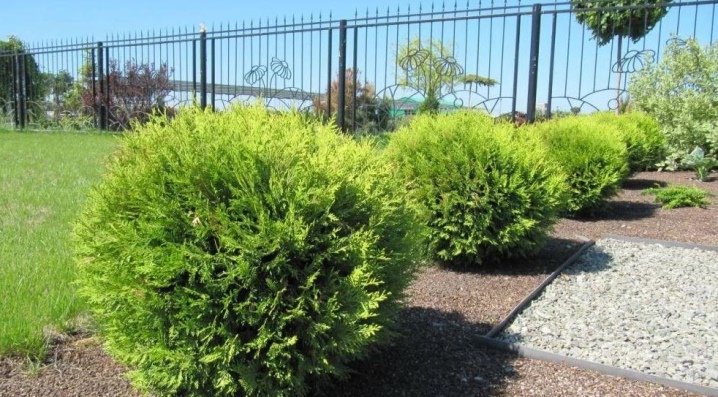
You can combine a coniferous tree with related plants. Landing in combination with cypress trees of different types is suitable. Also, "Yellow Ribbon" is well adjacent to Eastern spruce, European larch. For solitary (single) placement, it is recommended to surround the tree with a lush green lawn. In tree and shrub compositions, the thuja of this decorative variety provides the external appearance of the site with a decorative, noble appearance.
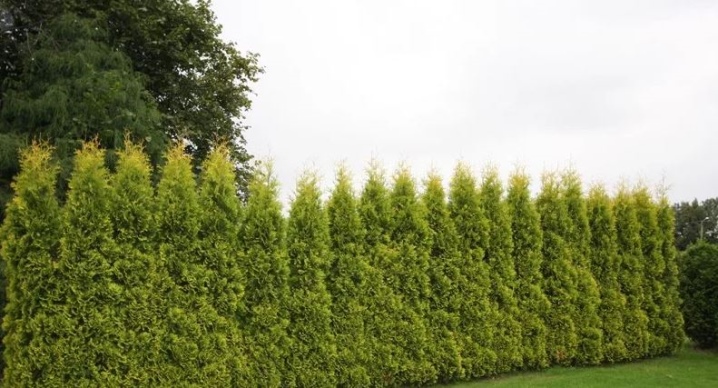
In a modern city, Yellow Ribbon is planted in recreation areas, in the immediate vicinity of schools or children's institutions, in the locations of hospitals, dispensaries, sanatoriums. In city squares and parks, the use of thuja in landscape design is also fully justified.
For information on how to properly care for the "Yellow Ribbon" thuja, see the next video.



































































The comment was sent successfully.